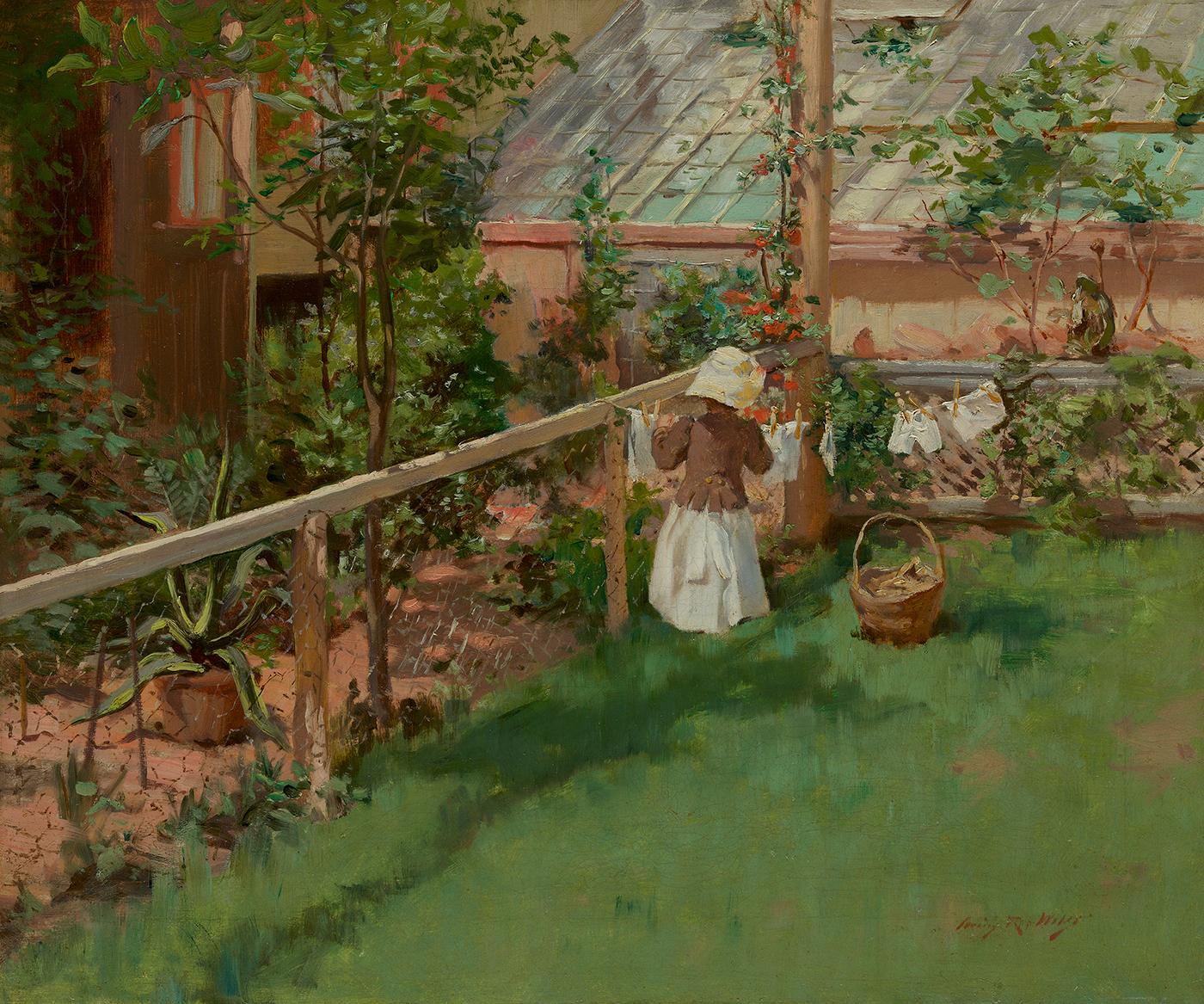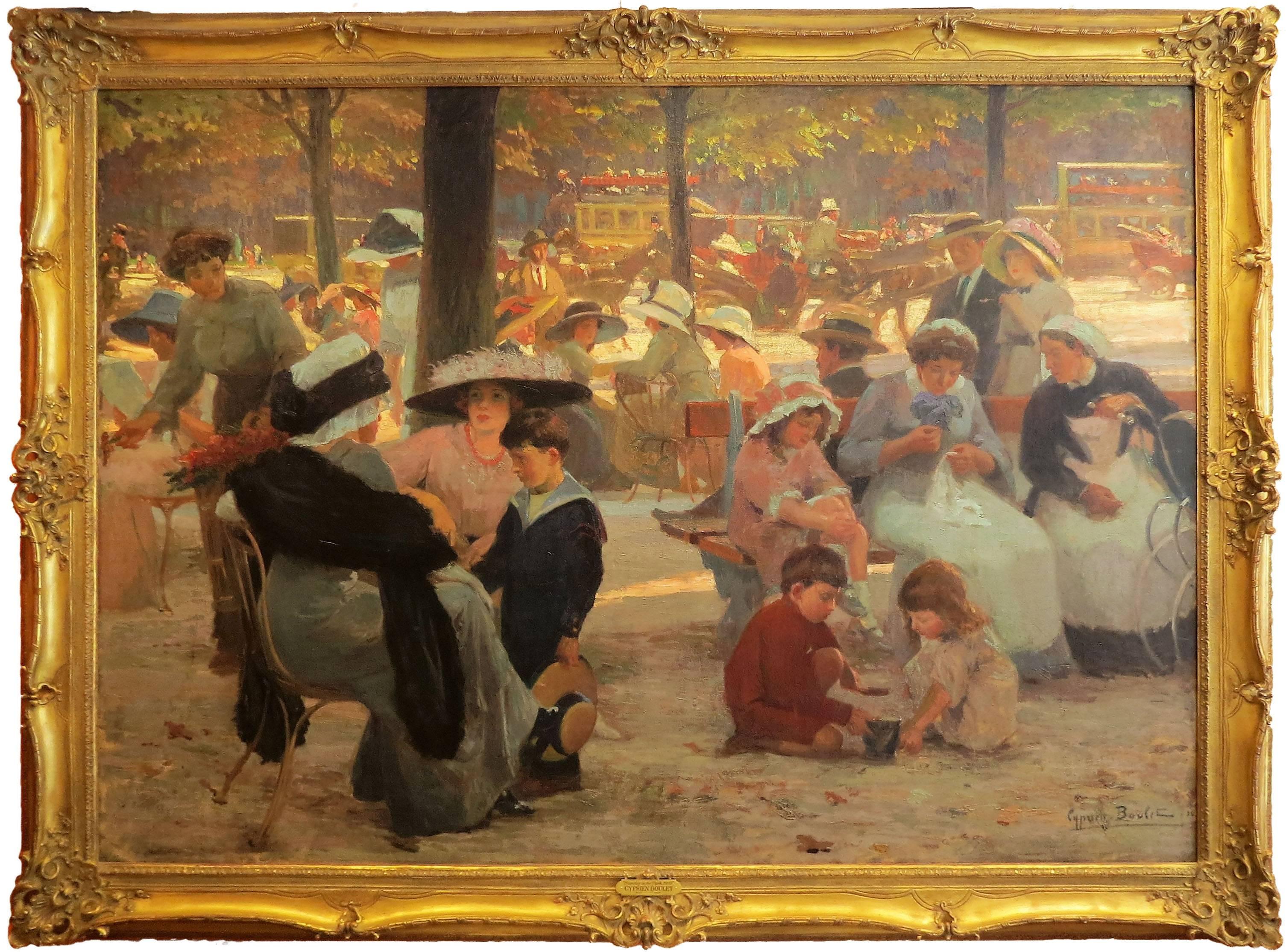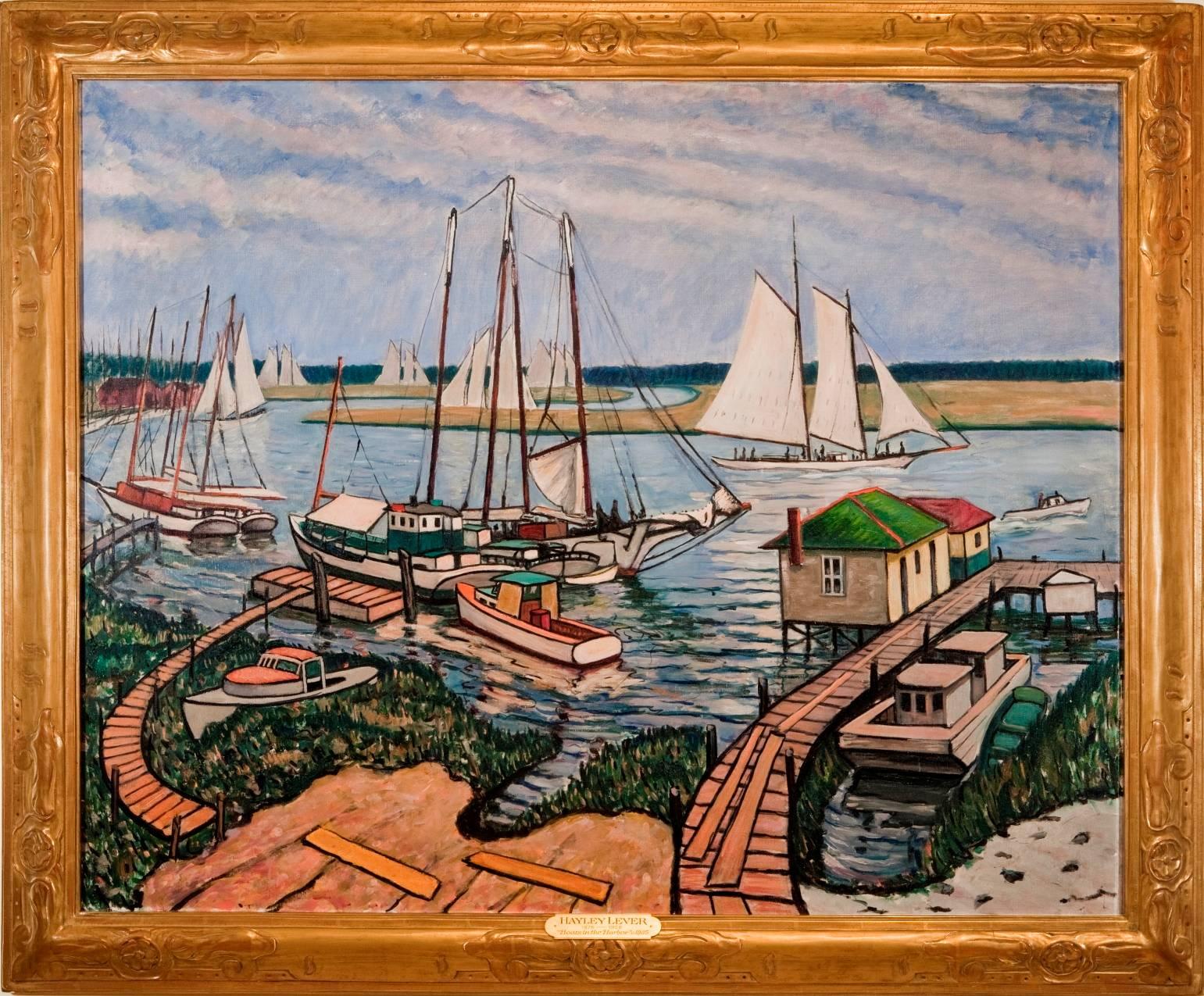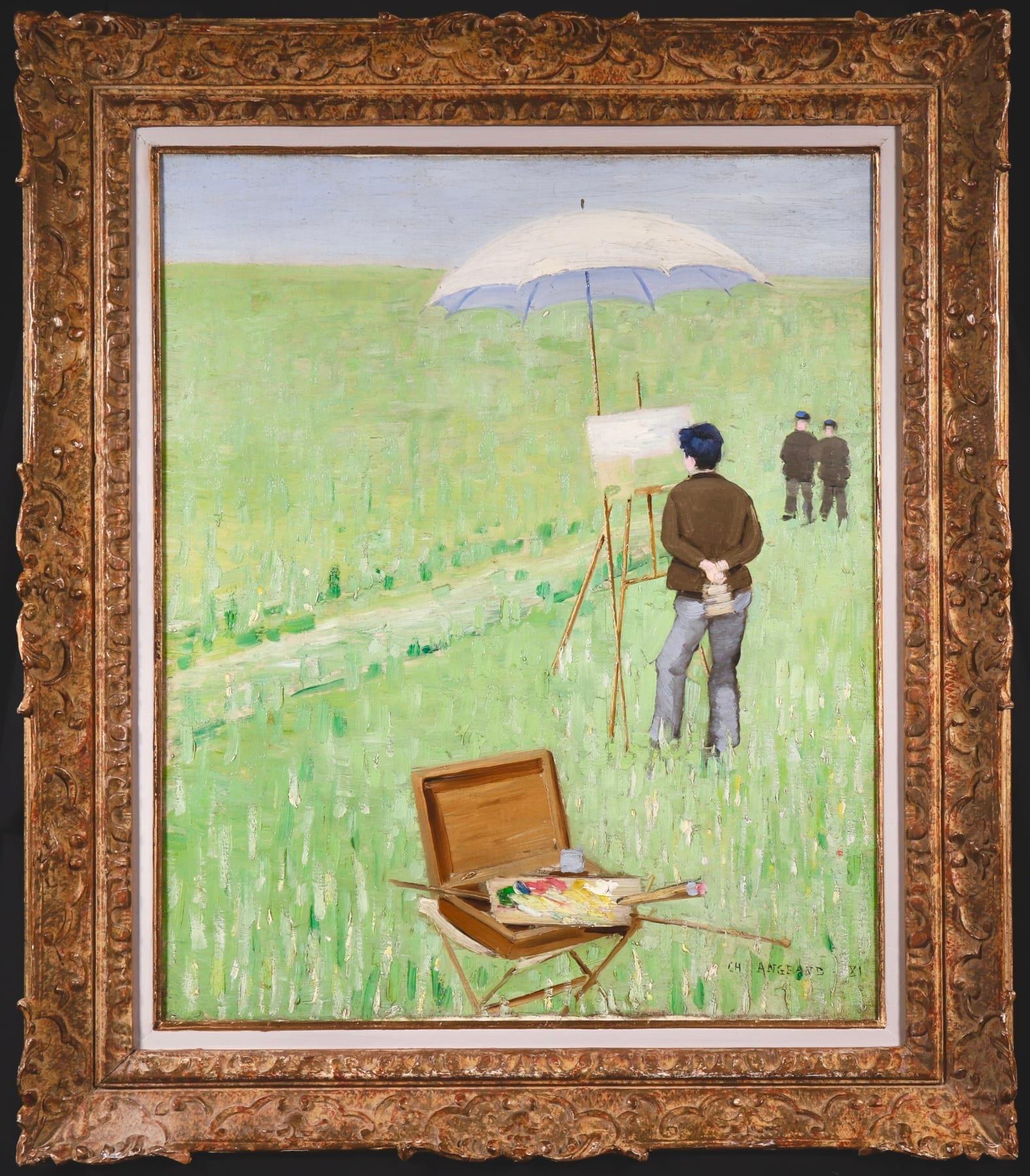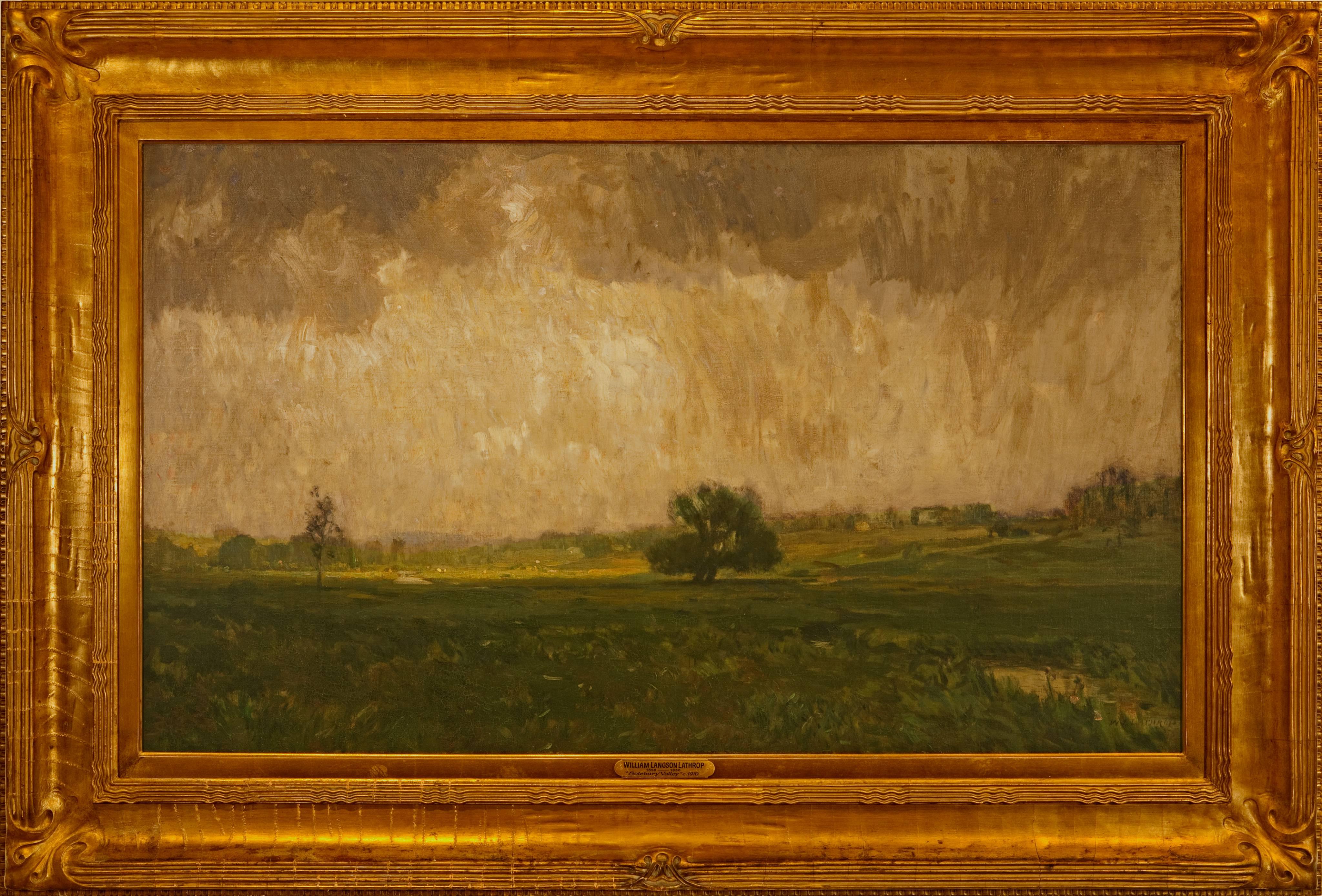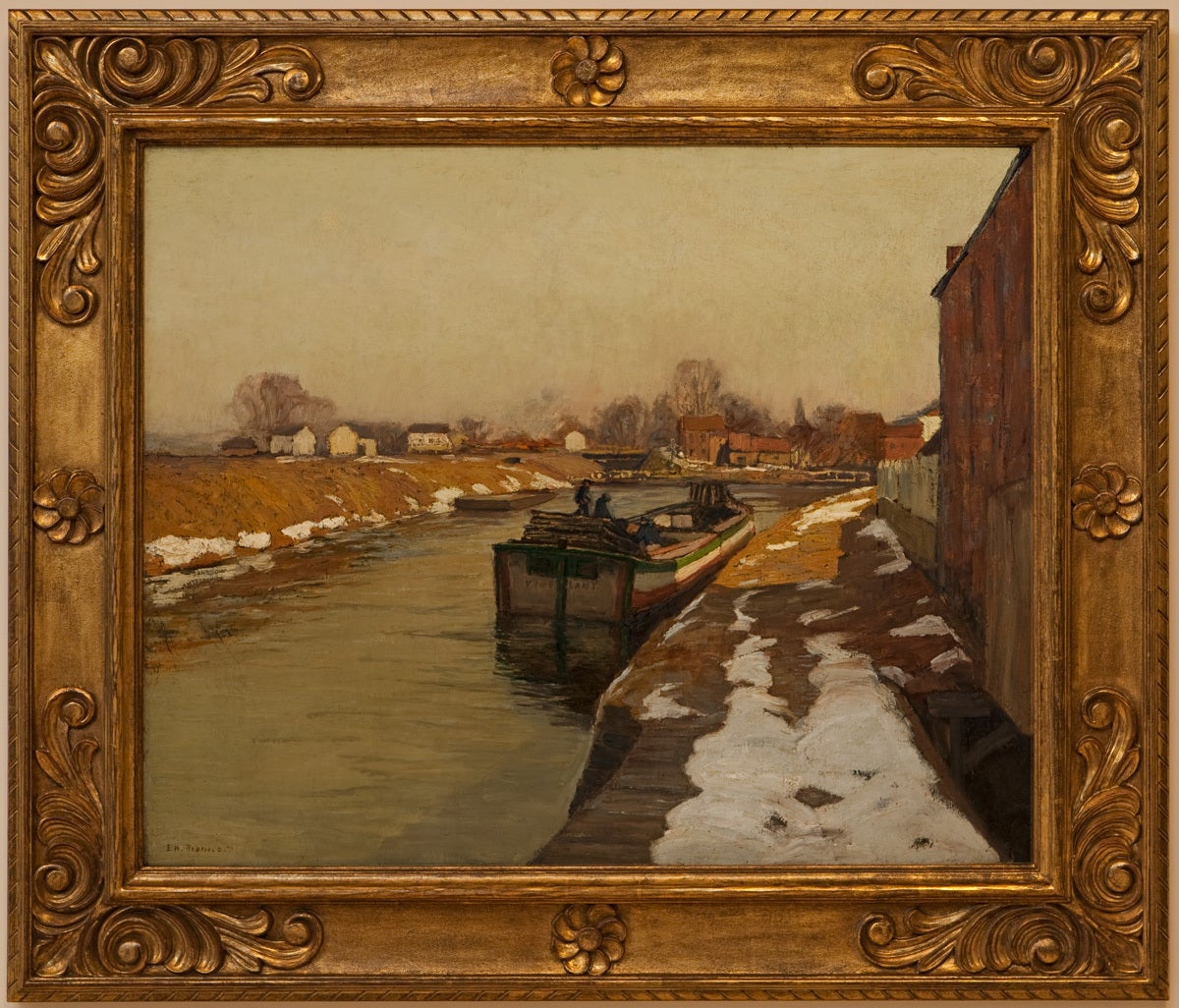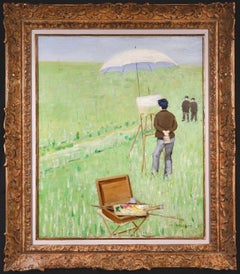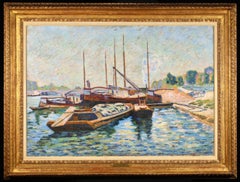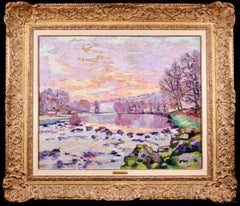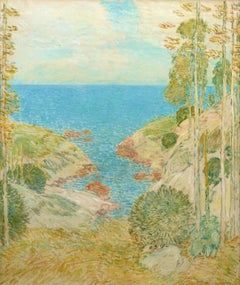
Sunset - Impressionist Oil, Sunset over Seascape by Vartan Makhokhian
View Similar Items
Want more images or videos?
Request additional images or videos from the seller
1 of 14
Vartan MakhokhianSunset - Impressionist Oil, Sunset over Seascape by Vartan Makhokhian1920
1920
About the Item
- Creator:Vartan Makhokhian (1869 - 1937, Armenian)
- Creation Year:1920
- Dimensions:Height: 27 in (68.58 cm)Width: 38 in (96.52 cm)
- Medium:
- Movement & Style:
- Period:
- Condition:Very good condition.
- Gallery Location:Marlow, GB
- Reference Number:Seller: LFA06921stDibs: LU41537173262
About the Seller
5.0
Platinum Seller
These expertly vetted sellers are 1stDibs' most experienced sellers and are rated highest by our customers.
Established in 2001
1stDibs seller since 2016
671 sales on 1stDibs
Typical response time: 3 hours
More From This SellerView All
- Painting en plein air - Impressionist Figure in Landscape Oil by Charles AngrandBy Charles AngrandLocated in Marlow, BuckinghamshireSigned and dated oil on canvas by French impressionist painter Charles Theophile Angrand. This wonderful and good-sized piece depicts an artist painting "en plain air" in a beautiful...Category
1880s Impressionist Figurative Paintings
MaterialsCanvas, Oil
- Peniches sur la Seine - Impressionist Landscape Oil - Armand GuillauminBy Jean Baptiste-Armand GuillauminLocated in Marlow, BuckinghamshireSigned impressionist landscape oil on canvas by French painter Jean Baptiste Armand Guillaumin. The work depicts barges moored on the b...Category
1880s Impressionist Landscape Paintings
MaterialsCanvas, Oil
- Dam at Genetin - Impressionist Oil, Winter Riverscape by Armand GuillauminBy Jean Baptiste-Armand GuillauminLocated in Marlow, BuckinghamshireSigned and dated impressionist landscape oil on canvas by French painter Jean Baptiste Armand Guillaumin. This simply stunning piece de...Category
Early 1900s Impressionist Landscape Paintings
MaterialsOil, Canvas
- Soleil Blanche - Impressionist Snowy River Landscape Oil by Armand GuillauminBy Jean Baptiste-Armand GuillauminLocated in Marlow, BuckinghamshireImpressionist oil painting on original canvas circa 1900 by French painter Jean Baptiste Armand Guillaumin. This simply beautiful piece...Category
Early 1900s Impressionist Landscape Paintings
MaterialsCanvas, Oil
- Bord De Mer - Impressionist Coastal Landscape Oil Painting by Willy SchlobachBy Willy SchlobachLocated in Marlow, BuckinghamshireSigned and dated pointillist landscape oil on canvas by Belgian impressionist painter Willy Schlobach. The piece depicts a coastal view looking out over the dark green sea to where it meets the powder blue sky on the distant horizon, with rock formations on either side. This work was executed in 1907 - the definitive mature period for Schlobach's work. Paintings by the artist executed between 1906 and 1908 are the pinnacle of his oeuvre and show the influence and ideas of neo impressionism brought by his friend and compatriot Theo van Rysselberghe who had learnt from Signac and Seurat in Paris. Schlobach painted numerous coastal views in this period which display a free approach to pointillism with theory being displaced by a desire to create luminosity and effect. Signature: Signed lower right and dated 1907 Dimensions: Framed: 29"x33" Unframed: 20"x24" Provenance: Private French collection Further information: This work was executed in 1907 - the definitive mature period for Schlobach's work. Paintings by the artist executed between 1906 and 1908 are the pinnacle of his oeuvre and show the influence and ideas of neo impressionism brought by his friend and compatriot Theo van Rysselberghe who had learnt from Signac and Seurat in Paris. Schlobach painted numerous coastal views in this period which display a free approach to pointillism with theory being displaced by a desire to create luminosity and effect. Willy Schlobach first studied at the Academy in Brussels and then later in Ghent. At the precocious age of nineteen he was already at the forefront of painters in Belgium numbering among his close friends Emile Verhaeren and Theo van Rysselberghe whose instructive influence on him was of great significance. He was one of the founding members of the group 'Les XX' who were broadly speaking avant-garde and influenced by the Parisian developments in painting but by no means uniform in their style or approach (see also have lots 201 and 233). Octave Maus, a lawyer and critic was the driving force behind 'Les XX' but the most important painter was Theo van Rysselberghe. Van Rysselberghe had lived and worked in Paris and brought to Belgium an intimate knowledge and understanding of the Neo-Impressionist techniques of Seurat and Signac which were to be a great influence on the younger generation of Belgian painters such as Willy Finch and Willy Schlobach. In the late 1880s Schlobach responded with enthusiasm to these new ideas emanating from Paris and produced some well structured and highly organised pointillist work in which his favoured subject matter was coastal scenes. Schlobach was also influenced by the other main group within 'Les XX' which was best represented by Fernand Khnopff. As well as working in a pointillist manner he produced paintings full of symbolism and reminiscent of the Pre-Raphaelites whose work he had studied and admired on visits to England. It is, however, in the neo-impressionist or luminist work that Schlobach found greater freedom of expression away from the sometimes claustrophobic subject matter of the symbolists. On his visits to London Schlobach had been influenced not only by the Pre-Raphaelite painters but also by the work of Turner whose atmospheric and misty paintings...Category
20th Century Impressionist Landscape Paintings
MaterialsOil, Canvas
- Pont Neuf - Evening - 19th Century Oil, Riverscape at Night by A E Othon FrieszBy Achille-Émile Othon FrieszLocated in Marlow, BuckinghamshireTHIS WORK IS CURRENTLY ON LOAN TO THE MUSEUM OF MODERN ART IN LE HAVRE AND IS BEING EXHIBITED IN THEIR ELECTRIC NIGHTS EXHIBITION 2020 A stunning oil on original canvas by Achile-Emile Othon Friesz depicting a night time view of the Pont Neuf bridge over the Seine, Paris. The painting shows deep blues and reds - richer than those of traditional impressionist paintings - and shows the transition into Fauvism. Signed and dated 1903 lower right. Framed dimensions are 24.5 inches high by 20 inches wide. Achille Friesz was the son of a family of sailors from Le Havre. From 1885 he often spent time in Marseilles visiting his maternal uncles. As a child he dreamed of going to sea, but from the age of 12 he developed a passion for art, and after secondary school he attended the École des Beaux-Arts in Le Havre. There, from 1896 to 1898, he studied under Charles-Marie Lhullier who had been a friend of Jongkind and whom, like Dufy and Braque, he remembered fondly throughout his life. Lhullier introduced his students to the work of Chardin, Corot, Géricault and Delacroix. After receiving a bursary from the local authorities in 1898, he went to Paris and, while his friends Matisse, Rouault and Marquet studied under Gustave Moreau, enrolled at the École des Beaux-Arts at the studio of Léon Bonnat, where he was joined by Dufy. However, he scarcely attended the studio, preferring to go to the Louvre and make copies of the works of Clouet, Veronese, Rubens, Claude Lorraine and Delacroix. He did his military service in Paris in 1902 but continued with his art. Around this time he met Camille Pissarro and sought his advice. As a young man he began to make frequent trips away, not necessarily travelling very far, but looking for subjects for his work, usually landscapes. Among the places he visited were the Creuse region around 1903, Antwerp in 1905, returning there with Braque in 1906, and La Ciotat, Cassis and L'Estaque in 1906-1907, again in the company of Braque. In Paris he frequently moved lodgings until 1914. He moved in with Henri Matisse at the Couvent des Oiseaux from 1905-1910, that is to say at the period when Fauvism was at its height. In 1908 he returned to his native Normandy to reimmerse himself in his early environment; he would return to the region throughout his life. He made a trip to Munich with Dufy in 1909, and visited Portugal in 1911-1912 and Belgium in 1912. In 1914 he was called up and assigned to technical services, not being demobilised until March 1919, although he did manage to maintain a certain independence. From 1914 until his death he lived in Paris at 73 Rue Notre-Dame-des-Champs, where he occupied Bouguereau's old studio. He made frequent trips to Cap-Brun near Toulon where, in 1923, he acquired a property called Les Jarres, as well as making numerous visits to Normandy and Le Havre. In 1925 he received the highest commendation at the Carnegie Prize in Pittsburgh for Portrait of the Decorative Artist Paul Paquereau. Also in 1925, at the same time as Matisse, he was made a Chevalier of the Légion d'Honneur, rising to in Officier in 1933 and Commandeur in 1937. He was also made Commander of the Swedish order of Vasa in 1934. Throughout his life, Friesz was a teacher: from 1913 at the Académie Moderne; from 1929 at the Académie Scandinave; and from 1941 until his death at the Académie de la Grande-Chaumière. Alongside his activity as a painter, he illustrated several works of literature, including: in 1920 Le Pacte de l'Écolier Juan by Jules Tellier; in 1924 Échelles de Soie by Jean Pédron; in 1926 Le Jardin sur l'Oronte by Maurice Barrès; in 1926 En Suivant la Seine by Gustave Coquiot; in 1929 Rouen by André Maurois; in 1931 The Song of Songs; in 1934 Poésies by Pierre de Ronsard; in 1945 Le Bouquet de la Mariée by Gabriel-Joseph Gros; in 1947 Paul et Virginie by Bernardin de St-Pierre; in 1949 Le Livre de Job by Pierre Poussard; in 1949 Petronius's Satyricon, and in 1949 a collection of 12 unpublished lithographs for Le Désert de l'Amour by François Mauriac. He also designed several pieces of decorative art: from 1906 to 1909 ceramics executed by Metthey among others; a façade for a private house in Le Havre; a china service for two for the Le Havre writer J.-G. Aubry; vases, dishes and plates; in 1912 four sets for La Lumière by Georges Duhamel, performed at the Odéon; in 1916 a screen for the Le Havre collector Léon Pédron; in 1918 panels for Pédron's dining room; in 1920 a mural entitled Children Dancing (Enfants Dansant); in 1920 Les Volières for the apartment of Vicomte Amédée de Flers; in 1935 Peace (La Paix), a Gobelins tapestry presented by France to the Palais des Nations in Geneva; in 1937 La Seine in collaboration with Dufy for the Palais de Chaillot, with each artist taking half of the river's course - From the Source to Paris by Friesz and From Paris to the Estuary by Dufy. The Fauves were producing Fauve paintings before they knew it: it was not until the critic Louis Vauxcelles saw their work at the Salon des Indépendants in 1905 and mockingly used the word Fauve to describe it that the term was born. It is known that Vlaminck and Derain worked together and that the École de Chatou was composed of just these two artists. Friesz was living with Matisse and after his first trip to Antwerp in 1905, he returned in 1906 with Braque. In 1906-1907 Friesz and Braque went to La Ciotat to paint and there they met up with Matisse. The paintings Friesz produced in Antwerp are Fauve inasmuch as they are painted in pure colours and are more or less free of the divisionism of the Impressionists, although the draughtsmanship is fairly standard; these works include The Port, The Escaut, The Canals, The Dock with Sailing Ships and The Red Slipway. Those of Braque the following year, in particular Terrace on the Escaut, show great similarities with those Friesz painted of the same subject. Friesz was already avoiding the hardness of pure flat tints by graduating them in thin glazes, allowing the whiteness of the canvas to penetrate the transparency, a technique that came to characterise his entire Fauve period. At La Ciotat Friesz and Braque adopted completely different Fauve styles, with Braque composing his paintings on horizontal and vertical orthogonals painted in small, regular, spaced-out touches, whereas Friesz developed his own personal rhythmical style of wide arabesques of colour in works such as The Bec-de-l'Aigle, Women Bathing and L'Estaque. Many of Friesz's Fauve works were produced in the south of France, and his Portrait of Fernand Fleuret also dates from this period. When he returned to Normandy in 1908 the period that he described as his 'return to form' began; with compromise paintings such as Entrance to the Port of Honfleur, Côte de Grâce Landscape, The 'Bains Marie-Christine' in Le Havre and the great compositions characteristic of this period - Autumn Labours, Spring, Fisherman on a Rock and Women Bathing. His draughtsmanship retains something of the rhythm of the Fauve period, his figures following the lines of the landscape and the colour remaining clear and resonant. In 1909 he painted the Cirque Médrano series: The Trapeze Artist, The Clown and The Horsewoman. In the south of France he also painted the Olive Trees series. He made a trip to Munich with Raoul Dufy resulting in Winter in Munich. This was also the year of his first trip to Italy. Boat in a Rocky Inlet of 1910 marks one of the pivotal points between a totally rhythmic drawing style of sensual curves typical of his Fauve period and a reduced palette of muted ochres, browns and blues. From 1910 onwards, the final traces of Fauvism become less and less apparent in his work. His use of colour follows the same course, towards the transcription of reality, with broken tones, ochres and browns. After his demobilisation, as well as in his studio in Paris, Friesz spent time in his house in Toulon, returned to Normandy and Le Havre and continued to make frequent, often local, forays in search of new subjects: in 1919 to Jura, producing the series Forests, Pine Trees, Road in the Snow and Invitation to Skate; in 1920 to Italy producing Piedmont Village, Florence Grape Pickers; in 1920 to Le Havre, producing The Étretat Cliffs, People Bathing at Étretat; in 1923 to his house in Toulon, producing View of Coudon, Women Bathing, Grape Harvesting, Jars; in 1924 he painted the Large Nude (which he exhibited at the Salon d'Automne the same year) and landscapes of Toulon; in 1928 he made a trip to Algiers, producing The Algiers Kasbah and its Phantoms; in 1931 to Annecy, producing Women Bathers by a Lake; in 1934-1935 to Dinan and St-Malo producing The Great Dinan Viaduct, The Dock with the Terre-Neuvas, After Bathing; in 1936 to Honfleur; in 1941-1944, remaining in Paris because of the war, he painted mainly still-lifes, including Studio Corner, Earthenware. In 1946 he returned to Honfleur; and in 1947 to La Rochelle producing The Port Tower, Tuna Boats, The Red Sail. Numerically Friesz's work is dominated by landscapes but it should be remembered that throughout his career he tackled more ambitious compositions and appeared to do so with great ease. These include Boat in a Rocky Inlet of 1910 with its frolicking women bathers, Allegory of War of 1915 executed in 24 hours, Invitation to Skate of 1919, numerous paintings of Women Bathing over several periods and much later Women beside a Pond of 1944, which clearly demonstrates his attachment to Cézanne. He exhibited at the Salon des Artistes Français from 1901 to 1903 and then at the Salon des Artistes Indépendants. From 1906 he exhibited annually at the Salon d'Automne, of which he later became a committee and jury member. In 1923 he took part in the founding of the Salon des Tuileries and became head of two of the Salon's sections. His work has been exhibited at countless group exhibitions all over the world. Among the most recent thematic exhibitions is Fauvism in Black and White. From Gauguin to Vlaminck, Fauvist Engraving and its Setting (Le Fauvisme en Noir et Blanc. De Gauguin à Vlaminck, l'Estampe des Fauves et son Environnement) at the Musée d'Art Moderne in Villeneuve d'Ascq in 2001. He also showed his work in numerous solo exhibitions in Paris: his first in 1904 at the Galerie des Collectionneurs and another the same year at the Société des Peintres du Paris Moderne...Category
Early 1900s Impressionist Landscape Paintings
MaterialsOil, Canvas
You May Also Like
- Lavnder Fields in Provence, French Oil PaintingLocated in Cirencester, GloucestershireThe Lavender Field French School, 20th century oil painting on canvas, framed framed size: 24.5 x 28.5 inches Lovely French oil painting on canvas depicting lavender growing in a P...Category
Late 20th Century Impressionist Landscape Paintings
MaterialsOil, Canvas
- Marine View, Isles of ShoalsBy Childe HassamLocated in New York, NYChilde Hassam paints a beautiful view out onto the ocean from between the trees in his artwork entitled, “Marine View, Isle of Shoals.”Category
Early 20th Century Impressionist Landscape Paintings
MaterialsCanvas, Oil
- "Moving the Wild Ones", Robert Hagan, 60x216, Oil/Canvas, Western, ImpressionismLocated in Dallas, TX"Moving the Wild Ones" by Robert Hagan is an original oil on canvas and measures 60x216. In this large original painting by Robert Hagan, cowboys on horseback run through the canyon mountains kicking up dust and trying to reign in runaway mustangs and they travel through the blue water and canyons. The contemporary cowboys are in trench coats with their cowboy hats flying off into the sky while holding Mustang Australian-style bullwhips that are ready to strike. Translating scenes of everyday life into nostalgic and blissfully peaceful visions of the world, Robert Hagan has become a premier Western artist of our time. A man of many talents his impressionistic style using a limited palette of oil brings a sense of tranquility that makes his paintings come alive. Robert Hagan is an Australian painter...Category
2010s Impressionist Landscape Paintings
MaterialsCanvas, Oil
- At the ClotheslineBy Irving Ramsey WilesLocated in New York, NYSigned lower right: Irving R. WilesCategory
Late 19th Century American Impressionist Landscape Paintings
MaterialsCanvas, Oil
- "Sunday in the Park, 1910"By Cyprien Eugène BouletLocated in Lambertville, NJSigned Lower Right Cyprien-Eugène Boulet (1877 - 1927)Category
Early 20th Century Impressionist Landscape Paintings
MaterialsCanvas, Oil
- "Boats in the Harbor"By Hayley LeverLocated in Lambertville, NJOriginal Period Frame Hayley Lever (1876 - 1958) Hayley Lever's exceptional career path took him from the shores of his native Australia to those of England, and then the United S...Category
1930s Impressionist Landscape Paintings
MaterialsCanvas, Oil
Recently Viewed
View AllMore Ways To Browse
The Sun Also Rises
Painting Antique Vanity
Dior Capri
Antique Monte Carlo
Italian Antique Violins
Antique American Violins
Antique German Violins
Seascapes Capri
Violin Ottoman
Cloud 9
Oak Park
Sunset Beach Painting
Utah Light
1920 Los Angeles
1920 Light School
American Southwestern Artists
Desert Landscape Artwork
Landscape Painting 18th Century French



